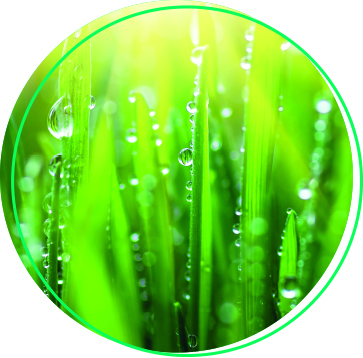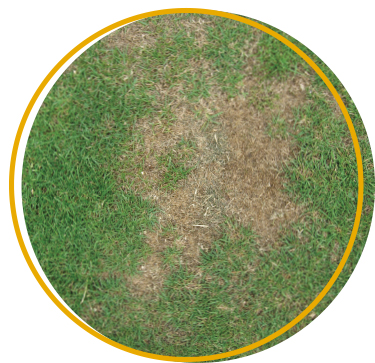Agrovista Amenity Specialist Ray Hunt gives a few tips on the use of wetting agents.
With high temperatures forecasted, it may well be worth looking at your current wetting agent programme to make sure you are using the correct product for your surfaces. In most cases, if the forecasters are right, holding moisture and dealing with dry patch will be the main priorities, therefore, the products you are using need to be well suited to the needs of your turf.
Water plays a significant role in all chemical, physiological and biological processes of plant growth. The soil/plant water relationships is crucial in relation to the sustainability of any grass plant. Understanding these relations is critical. All grass plants are a continuum of water movement, with over 90% of the plant's water requirements being transported through the plant from the soil profile, via the roots and stem tissues, into the leaves and out into the atmosphere.
In recent years we have seen a rise in demand for wetting agents to help improve the soils’ ability to take in water. Wetting agents are used to reduce the surface tension of water and improve the ability of soils on golf courses to make best use of available water and help increase water infiltration. In the UK, numerous wetting agents are available, with each product performing slightly differently depending on its formulation, dose rate and suggested programme of use.
Wetting agents enable turf managers to improve turf performance by improving infiltration, retention and uniformity of moisture within the rootzone. This can be achieved in a number of ways.
Some wetting agent active substances reduce the surface tension of water molecules allowing them to penetrate through the soil profile more effectively.

Other wetting agent active substances combat the problem of dry patch by stripping off the waxy organic coating on the soil particle which renders the soil profile water repellent. However, this may never totally alleviate the problem as the waxy coating will reform as a result of natural processes of plant and fungi biodegradation. In addition to this, sand particles are particularly susceptible to developing this waxy coating so every time you top-dress with sand, you add a further layer of particles which are prone to becoming water repellent. This type of wetting agent is believed by some to also remove beneficial bacteria from the soil and therefore can be controversial. Although, one of the lesser-known facts is that when using wetting agents which remove waxy coatings on soil particles your water consumption can reduce by up to 30% year on year.

The best results of applying wetting agents are achieved by starting early in the season before symptoms are observed. Blanket applications are recommended as opposed to spot treatments as a more effective approach. The longevity of each product depends on the dose rate, therefore, subsequent applications should occur as the suggested period of effective control elapses for each product, or according to observed patterns of efficacy in the field. Different wetting agent formulations also have different expectations of longevity. Some are intended only to work over a short period of time to alleviate a specific problem. Others can remain effective for months, providing a residual effect.
To achieve the best from wetting agents, any factors contributing to the dry patch should be addressed before application. This may include alleviation of compaction, removal of thatch and preventing the rootzone from reaching the critical moisture content by ensuring even and timely irrigation.
These factors may affect the results of the wetting agent depending on the circumstances, i.e. if you have a high thatch content, it is important to use a wetting agent which will improve penetration through the soil profile to increase surface dryness Conversely, a substrate that is very free draining, e.g. a USGA spec green, would benefit from a wetting agent which improves water retention as moisture within the rootzone is a limiting factor.
Over recent years I have witnessed Aqua-Zorb liquid transform golf courses suffering from hydrophobicity with only one application which lasts up to five months. This is a truly unique product which outperforms its competitors on a regular basis. If you are looking for a reliable one application product that cures hydrophobicity, then this product has to be at the top of your considerations.
How does Aqua-Zorb liquid work?
Dry patch (hydrophobic soil) is the result of soil fungi secreting a wax which coats the soil particles, making them repel water.
Trials demonstrated that Aqua-Zorb effectively removed the waxy coating from the soil particles, allowing water to penetrate the soil more effectively.
Studies have shown that a greater rooting length occurs following treatment, which helps to reduce the effect of summer stress and improve both nutrient and water uptake.
Benefits of using Aqua-Zorb liquid
· Long lasting residual technology (up to five months)
· Improved both turf colour and quality
· Improved root systems, thereby reducing summer stresses
· Improved drainage of compacted sports turf surfaces
· Prevention and cure of LDP and the correction of water repellent turf to subsequently increase the speed and the depth of water penetration through thatch and LDP areas
· Ensures a more economical use of applied fertilisers and fungicides
· Irrigation water can be reduced by up to 50%
· Autumn application will ensure improved drainage of winter rainfall and actively reduce the formation of dew
· Excellent value for money

You can find out more about our Aqua-Zorb range of water management products here or by speaking to your local Agrovista Amenity Specialist.

